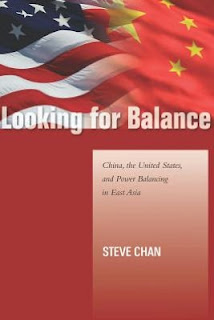 New from Stanford University Press: Looking for Balance: China, the United States, and Power Balancing in East Asia by Steve Chan.
New from Stanford University Press: Looking for Balance: China, the United States, and Power Balancing in East Asia by Steve Chan.About the book, from the publisher:
Debate surrounding "China's rise," and the prospects of its possible challenge to America's preeminence in international relations in East Asia, has focused on two questions, rooted in power-balancing theory: whether the United States should "contain" or "engage" China; and whether the rise of Chinese power has inclined other East Asian states to "balance" against Beijing by alignment with the United States.
By drawing on alternative theoretic approaches—most especially "balance-of-threat" theory, political economic theory, and theories surrounding regime survival in multilateral rather than bilateral contexts, Steve Chan is able to create an explanation of what is in motion in the region that differs widely from the traditional "strategic vision" of national interest.
He concludes that China's primary IR aim is not to match U.S. military might or the foreign policy influence that flows from that power, and that its neighbors are not balancing against its rising power. This is because, in today's guns-versus-butter fiscal reality, balancing policies would entail forfeiting possible gains that can accrue from cooperation, economic growth, and the application of GDP to nonmilitary ends. Instead, most East Asian countries have collectively pivoted to a strategy of elite legitimacy and regime survival based on economic performance.

